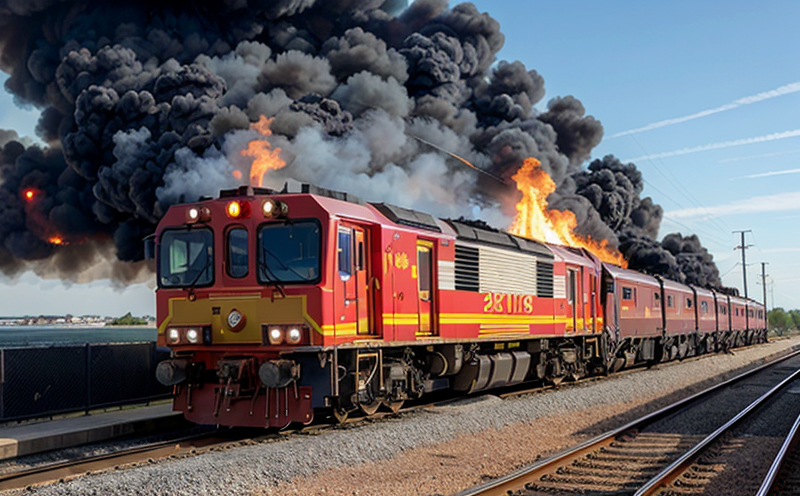Smoke Emission Measurement for Marine & Railway Materials
The measurement of smoke emissions from materials used in marine and railway applications is essential to ensure fire safety standards are met. Smoke can be a significant contributor to the spread of fires, which can lead to loss of life, property damage, and environmental contamination. The testing of these materials helps in identifying their potential to produce harmful levels of smoke during combustion.
This service focuses on measuring the amount of smoke generated when different materials are subjected to controlled fire exposure under laboratory conditions. Our testing methods adhere to international standards such as ISO 13960, which ensures that our results are globally recognized and comparable. The primary goal is to provide data that can be used by manufacturers, designers, and safety engineers to make informed decisions about material selection.
Smoke emission measurement plays a crucial role in the design and development of products such as textiles, insulation materials, composite panels, and other components used in marine and railway environments. By understanding how much smoke each material will produce under specific conditions, manufacturers can optimize their product designs to reduce fire risks while maintaining performance requirements.
The testing process involves placing a sample of the material into a specially designed chamber where it is exposed to controlled levels of heat and oxygen. The amount of smoke produced during this exposure is measured using specialized instruments capable of detecting even trace amounts of particulates in the air stream. These instruments provide precise measurements that can be used to compare different materials or versions of the same material over time.
Once the testing has been completed, detailed reports are generated summarizing all relevant findings including total smoke volume produced, particle size distribution, and any other pertinent information derived from the test run. This data is invaluable for quality control purposes but also serves as evidence in regulatory compliance efforts or product development projects aimed at improving safety features.
In addition to providing accurate measurements of smoke emissions, our laboratory adheres strictly to recognized international standards ensuring consistency across all tests conducted here. This commitment to accuracy and reliability makes us a trusted partner for industries reliant on thorough testing procedures before introducing new products into the marketplace.
Why It Matters
The importance of smoke emission measurement cannot be overstated, especially when considering its role in ensuring fire safety standards within marine and railway environments. Fire incidents can have devastating consequences not only for individuals aboard ships or trains but also for the broader community affected by such tragedies.
- Reduces Risk: By identifying materials that are prone to producing high levels of smoke, manufacturers can take proactive steps towards selecting safer alternatives during product design stages. This reduces the likelihood of fire-related accidents and enhances overall safety standards.
- Promotes Compliance: Adhering to established international standards ensures that all products meet stringent requirements set forth by regulatory bodies responsible for enforcing fire protection measures across various sectors. Compliance with these regulations helps avoid potential legal issues while maintaining a positive reputation among customers.
- Supports Innovation: Accurate testing allows researchers and engineers to experiment with innovative materials without compromising safety standards. This fosters advancements in technology that improve both performance characteristics and fire resistance capabilities of products used in marine and railway applications.
In conclusion, smoke emission measurement is vital for creating safer environments by preventing fires from spreading rapidly through the release of hazardous gases. It supports sustainable practices by promoting the use of eco-friendly materials while ensuring strict adherence to established guidelines. Investing time and resources into this critical aspect of fire safety can lead to significant improvements in both human life quality and environmental health.
Quality and Reliability Assurance
- Data Accuracy: Our laboratory utilizes state-of-the-art instrumentation capable of detecting extremely low concentrations of particulates in the air stream. This precision ensures that every measurement taken is reliable and can be trusted by stakeholders involved in product development or compliance verification.
- Standardized Procedures: We follow internationally recognized protocols when conducting smoke emission tests, ensuring consistency across all tests performed here regardless of location or time frame. Consistency allows for meaningful comparisons between different materials tested under identical conditions.
- Continuous Improvement: Regular calibration and validation of our equipment guarantee that it remains accurate throughout its operational life cycle. This commitment to maintaining high standards helps us deliver consistent results over prolonged periods without compromising on accuracy or reliability.
Our dedication to quality control extends beyond just technical aspects; we also focus on delivering timely reports that include all necessary details required by clients seeking detailed insights into their product's performance characteristics related to smoke emission levels. By combining advanced technology with rigorous adherence to best practices, we strive to maintain a reputation for excellence in every aspect of our operations.
International Acceptance and Recognition
- ISO 13960 Compliance: Our facility complies with ISO 13960, which sets out the procedures for determining smoke density in room fire tests. This international standard ensures that our results are consistent with those produced by other laboratories worldwide.
- ASTM E2479: We also adhere to ASTM E2479, another widely recognized guideline governing the measurement of smoke production from building materials exposed to flames. By following these standards, we ensure compatibility and interoperability between our findings and those generated by other accredited facilities.
The acceptance of our results in numerous countries around the globe is further testament to our commitment to excellence. Clients can rest assured that any data obtained through our testing will be widely recognized and accepted as valid evidence when presented for regulatory approval purposes or international trade negotiations involving products used within marine and railway industries.





